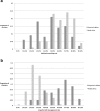What Drives Variation in Antibiotic Prescribing for Acute Respiratory Infections?
- PMID: 27067351
- PMCID: PMC4945551
- DOI: 10.1007/s11606-016-3643-0
What Drives Variation in Antibiotic Prescribing for Acute Respiratory Infections?
Abstract
Background: Acute respiratory infections are the most common symptomatic reason for seeking care among patients in the US, and account for the majority of all antibiotic prescribing, yet a large fraction of antibiotic prescriptions are inappropriate.
Objective: We sought to identify the underlying factors driving variation in antibiotic prescribing across clinicians and settings.
Design, participants: Using electronic health data for adult ambulatory visits for acute respiratory infections to a retail clinic chain and primary care practices from an integrated healthcare system, we identified a random sample of clinicians for survey.
Main measures: We evaluated independent predictors of overall prescribing and imperfect antibiotic prescribing, controlling for clinician and site of care. We defined imperfect antibiotic prescribing as prescribing for non-antibiotic-appropriate diagnoses, failure to prescribe for an antibiotic-appropriate diagnosis, or prescribing a non-guideline-concordant antibiotic.
Key results: Response rates were 34 % for retail clinics and 24 % for physicians' offices (N = 187). Clinicians in physicians' offices prescribed antibiotics less often than those in retail clinics (53 % versus 67 %; p < 0.01), but had a higher imperfect antibiotic prescribing rate (65 % versus 31 %; p < 0.01). Feeling rushed was associated with higher antibiotic prescribing (OR 1.34; 95 % CI 1.03, 1.75). Antibiotic prescribing was also associated with clinician disagreement that antibiotics are overused (OR 1.60, 95 % CI, 1.16, 2.20). Imperfect antibiotic prescribing was associated with receiving antibiotic prescribing feedback (OR 1.35, 95 % CI 1.04, 1.75) and disagreement that patient demand was a problem (OR 1.66, 95 % CI 1.00, 2.73). Imperfect antibiotic prescribing was less common with clinicians who perceived that they prescribed antibiotics less often than their peers (OR 0.63, 95 % CI 0.46, 0.87).
Conclusions: Poor-quality antibiotic prescribing was associated with feeling rushed, believing less strongly that antibiotics were overused, and believing that patient demand was not an issue, factors that can be assessed and addressed in future interventions.
Keywords: acute respiratory infections; antibiotics; overuse; prescribing.
Conflict of interest statement
Funders
This work was supported by grant # R21-AI097759 from the National Institute of Allergy and Infectious Diseases (PI: Dr. Mehrotra). Dr. Linder’s work on acute respiratory infections was also supported by grants from the National Institutes of Health (RC4 AG039115) and the Agency for Healthcare Research and Quality (R18 HS018419).
Prior presentations
None.
Conflict of Interest
The authors declare that they do not have a conflict of interest.
Figures
References
-
- Centers for Disease Control and Prevention. Get Smart: Know When Antibiotics Work. http://www.cdc.gov/getsmart/community/index.html (February 1 2016, date last accessed)
-
- Ranji SR, Steinman MA, Shojania KG et al. Closing the Quality Gap: A Critical Analysis of Quality Improvement Strategies (Vol. 4: Antibiotic Prescribing Behavior). Rockville MD; 2006 - PubMed
Publication types
MeSH terms
Substances
Grants and funding
LinkOut - more resources
Full Text Sources
Other Literature Sources
Medical


